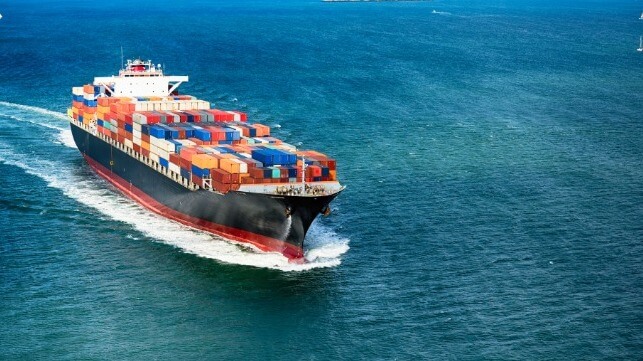Containership Markets Set Records for Secondhand Sales and Orders

With capacity remaining constrained and demand still at peak levels, the containership market continues to set new records. Both construction orders and sales of existing ships set new records in 2021 fueled by extraordinary profits for the major carriers. Analysts expect the markets to remain strong well into 2022 with additional carriers just this week ordering more new containerships.
The orderbook for containerships continued to build volume through all of 2021 maintaining a record pace. While many of the orders were in the 15,000 TEU range, which carriers consider the most versatile size for ships, there were an increasing number of orders for ever-increasing ultra-large containerships. At the end of 2021, China’s Hudong Zhonghua Shipbuilding floated Evergreen Line’s newest containership, which is being called the world’s largest containership based on rated capacity. The new ship, named Ever Alot, is rated for just over 24,000 TEU and will be joined by new ultra-large vessels ordered for MSC, Hapag Lloyd, and Ocean Network Express (ONE).
U.K.-based Clarkson Research calculated that a record total of 548 ships were ordered in 2021 which was better than 11 percent ahead of the orders in 2020. The total capacity for the new ships ordered last year is set at 4.2 million TEU, bringing the total for contracted containerships to 5.7 million TEU. The orderbook represents nearly a quarter of the current global containership capacity, although some of the new ships will be replacements to existing tonnage.
Anxious to gain near-term capacity the carriers turned to the secondhand market setting another record for ship sales in 2021. Demand was high for even aging ships that might in other times have been destined for recycling.
“The number of container vessels changing hands reached an all-time high in 2021 after shipowners appeared willing to pay almost any price to secure tonnage in the frenetic post-COVID market,” writes Alphaliner in a new report on the containership market. They calculate that a total of 572 containerships were sold during 2021, “equivalent to a breathtaking 1.94 million TEU, the first time annual sales have exceeded 1.6 million TEU. The year set new records both by TEU volume and the number of deals.”
The strength of the container market helped to rescue firms that had been facing deep financial troubles, including South Korea’s HMM and Singapore’s Pacific International Lines. Saddled with a deep debt load, PIL avoided bankruptcy in 2021 and by the end of the year was making early repayments on its debt.
The new year is beginning equally strong across all segments of the container market. PIL, which was returned to financial health by the strong market, started 2022 with an order for its first new ships in seven years. The ship ordered, two 16,000 TEU boxships with an option for two additional vessels, will be the largest ever for Pacific International and its first LNG-fueled ships.
While much of the focus has been on the large containerships, the feeder ship end of the market was equally strong and continues to show positive trends. Athens-based operator Euroseas demonstrated its faith in the market placing a further order for two additional 2,800 TEU feeder ships with South Korea’s Hyundai Mipo Dockyard. The vessels, which will each have a capacity of 2,800 TEU and are due late in 2023 and early 2024, are sister ships to two ships Euroseas has on order. The first two ships on order are not due for delivery till the first and second quarter of 2023, but they decided to proceed with the additional order.
Analysts highlight that the new orders are not due to arrive in the market until 2023 and 2024 helping to ensure the near-term strengths in container shipping. Further, while a large amount of capacity is due to enter the market they also point out that it will be spaced out giving the markets time to absorb the new ships.
